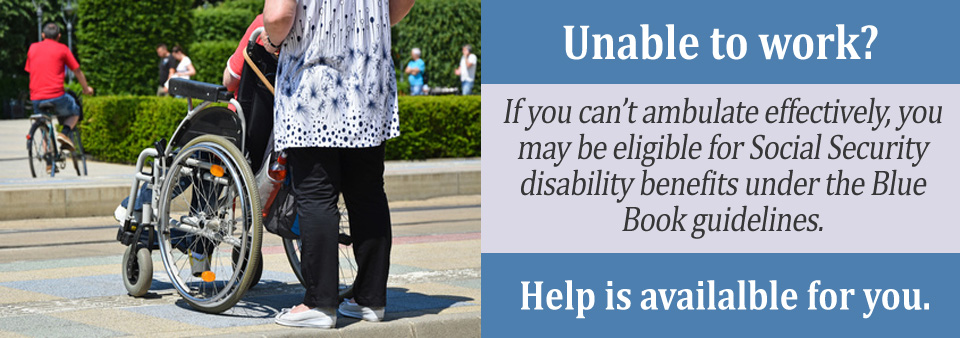Applying for disability benefits can be tricky, especially when figuring out if you may qualify for benefits. The Social Security Blue Book is a great resource to refer to here, but even the Blue Book uses language that may be difficult to understand.
If your disorder requires an inability to “ambulate effectively,” continue below to learn what this term means and how you can provide evidence of this on your disability application.
The Blue Book’s Definition of Ambulating Effectively
Before we discuss ambulation specifically, it is important to understand how to qualify for disability benefits in general. To qualify for benefits, applicants must be able to prove that their condition is severe enough to leave them “totally and permanently disabled.”
Those who are totally and permanently disabled show an inability to work, complete daily tasks, or care for themselves without assistance, to the point where they are unable to work or live normally. One of the ways many people with musculoskeletal disorders can prove this is by showing an inability to ambulate effectively.
In general, the word “ambulate” refers to the ability to walk or move around. While the Blue Book definition does refer to this kind of ambulation, its terms are much more specific.
According to the Blue Book, an inability to ambulate effectively means “an extreme limitation of the ability to walk” due to “an impariment(s) that interferes very seriously with the individual’s ability to independently initiate, sustain, or complete activities.”
An inability to ambulate can also be described as having “insufficient lower extremity function” that prevents a person walking on their own without the use of assistive devices that limit the use of both hands at any given time.
Thus, in order to “ambulate effectively,” individuals must be able to walk over a sufficient distance (not just within the home) and complete their normal daily tasks without the help of a companion.

Some direct examples of ineffective ambulation include:
- the inability to walk without a walker
- the use of two canes or crutches when walking
- the inability to walk safely or at a reasonable pace over rough/uneven surfaces
- the inability to use standard public transportation
- the inability to complete normal daily tasks, such as shopping or banking
If one or more of these applies to you, then it is likely you qualify for benefits under this Blue Book requirement.
How to Prove Ineffective Ambulation
The best way to see if you qualify for disability benefits for being unable to ambulate effectively is to speak with your physician or physical therapist. Some of the tests you may be able to take to determine ambulatory ability include:
- ambulation and range of motion tests
- spinal function/stretch tests
- motor function tests
- general walk tests (6-minute or 10-minute)
- residual functional capacity evaluations
Because a variety of disorders hinder the ability to walk or move unassisted, you may require many or none of the tests listed above.
For example, some forms of amputations (such as an amputation of both hands) do not require you to take ambulation assessment tests — the mere absence of both hands need be proved in order to receive benefits.
However, the absence of one or both lower extremities must demonstrate an inability to use prosthetic devices to ambulate effectively, which may require testing.
Other disorders that may require ambulation testing include spinal stenosis, arachnoiditis, degenerative disc disease, osteoarthritis, severe soft tissue injury, or bony/fibrous ankylosis.
In addition to testing, it is also important to include evidence of any method you have used to try and improve your ambulation. This includes therapy session notes, statements from your therapist(s), assistive device lists, or medication lists pertaining to your ambulatory problems.
In general, the more evidence you provide showing your “total and permanent disability,” the more likely you are to get benefits.
Next Steps
After speaking with your physician and gathering necessary paperwork, you can begin your disability application on the Social Security website whenever you are ready. However, before you begin your application, it may be wise to consider speaking with a disability attorney.
Their knowledge of medical terminology, the application process, and the Social Security system can greatly improve your chances of getting approval.
In addition, disability attorneys are paid differently than most attorneys — since they are federally regulated, you do not pay your disability attorney unless their efforts help you to win your case.
Before starting your application, consider a free consultation with a disability attorney in your area today.